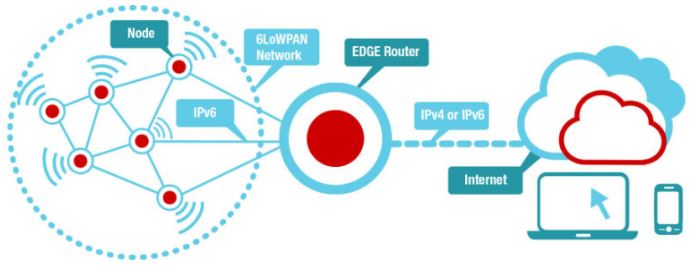6LowPAN stands for Internet Protocol version 6 over low power Personal Area Networks. It defines encapsulation and header compression mechanisms. It can be used across multiple platforms like Ethernet, Wi-Fi, IEEE 802.15.4 and sub-1GHz ISM. The IPv6 stack is the key attribute which has been a significant development to support internet of things (IoT) applications compared to its predecessor IPv4. It can offer up to an enormous address of 5 × 1028, which can enable any embedded device or object in the world to have their own unique ID.
IPv6 protocol provides transport mechanism to design complex control systems and to communicate with devices in a cost effective way and employing a low-power wireless communication. It implements open IP standards like Transmission Control Protocol (TCP), User datagram protocol (UDP), Hyper Text transfer Protocol (HTTP), Constrained Application Protocol (COAP), Message Queuing Telemetry Transport (MQTT) and web sockets.
Key benefits of 6LowPAN in IoT applications
For IoT applications requiring mesh network and low power consumption, 6LowPAN low power wireless technology might be the most obvious choice.
- Embedded devices in an IoT network using low power wireless mesh networks can effectively use the benefits of powerful of IPv6.
- It is ideal to create mesh networks. It can carry IPv6 or IPv4 data packets over the IEEE 802.11 standards. It can provide seamless connectivity to different networks using the same standard.
- Low data rates – It can provide connectivity to smaller devices in an IoT network requiring low data rate.
- Low power – It can provide seamless connectivity with the internet yet consuming very low power.
- Security – Poorly secured IoT devices are prone to get hacked. 6LowPAN low power wireless communication uses AES-128 link layer security defined in IEEE 802.15.4 which provides link authentication and encryption. Other security mechanisms, most popularly digital signature or TLS can also be implemented on top of the IP protocols.
Working of 6LowPAN
The lower layer of this wireless protocol is provided by the IEEE 802.15.4. However, there are incompatibilities between the IPv6 format and the formats allowed by the IEEE 802.15.4. But these incompatibility issues can be overcome within the 6LowPAN and thus the system can be used as a layer over the basic IEEE 802.15.4. So, if we want to send a data packet on IPv6 over 6LowPAN there has to be a mechanism in place which can convert these data packet into a format that can be supported by the IEEE 802.15.4 lower layer.
A minimum of MTU or Maximum Transmission Unit should be at least 1280 bytes in length which is much longer than the 127 octets standard packet size of the IEEE 802.15.4. To overcome this IPv6 are assigned 128-bit address. So, either a 64-bit extended address or 16-bit address can be used by IEEE 802.15.4 devices that are unique within a Personal Area Network. A group of physically co-located IEEE 802.15.4 devices also have a PAN ID.
There are three different kinds of 6LowPANs –
- Simple LowPANS
- Extended LowPANs
- ad-hoc LowPANS
A Simple LowPAN connects via one Edge Router to another IP network. An extended LowPAN has a backbone link e.g. Ethernet to connect the LowPANs of multiple edge routers. An ad-hoc LowPAN is not connected to the internet but operates without any infrastructure.
Edge Routers connect the LowPANs to other IP networks and it routes the traffic in and out of the network. It also handles compression and Neighbour Discovery for the LowPAN. Multiple Edge Routers can be used in the same LowPAN network if a common backbone link is shared. If the LowPAN operates on IPv4, the Edge Router will also handle IPv4 interconnectivity. The 6LowPAN architecture consists of low power wireless area networks which are IPv6 stub networks.

6LowPAN vs ZigBee
Both 6LowPAN and ZigBee top the wireless connectivity solutions for IoT networks. Both the technologies have a wide base of hardware community and vendor support. ZigBee has been there in the market for quite a long time whereas 6LoWPAN is a newbie. Since 6LowPAN supports IPv6, it easily wins over ZigBee on communication and interoperability. Both technologies ensure security of their data over the network but ZigBee scores over 6LowPAN on this. We can see that both the technologies have their pros and cons, however it solely depends upon the requirement of your application as to which protocol will provide the optimal solution.
Author
Anupama kumari
M.Tech (VLSI Design and Embedded system)
BS Abdur Rahman University
